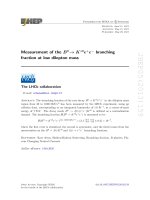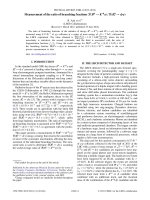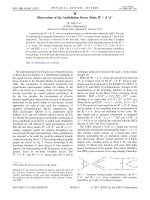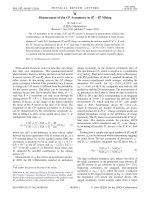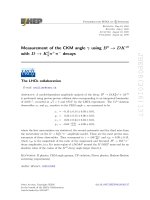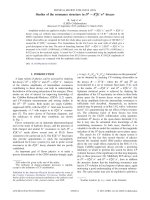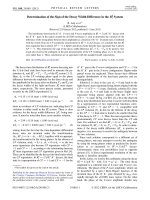DSpace at VNU: Influence of doped rare earth elements on electronic properties of the R0.25Ca0.75MnO3 systems
Bạn đang xem bản rút gọn của tài liệu. Xem và tải ngay bản đầy đủ của tài liệu tại đây (1.08 MB, 4 trang )
Computational Materials Science 50 (2010) 2–5
Contents lists available at ScienceDirect
Computational Materials Science
journal homepage: www.elsevier.com/locate/commatsci
Influence of doped rare earth elements on electronic properties
of the R0.25Ca0.75MnO3 systems
Nguyen Hoang Linh a,*, Nguyen Thuy Trang a, Nguyen Tien Cuong a, Pham Huong Thao b, Bach Thanh Cong a
a
b
Faculty of Physics, Hanoi University of Science, Vietnam National University – Hanoi, Vietnam
Faculty of Physics, Hue University of Education, Hue University, Vietnam
a r t i c l e
i n f o
Article history:
Received 29 October 2009
Received in revised form 25 February 2010
Accepted 1 March 2010
Available online 1 April 2010
Keywords:
Calcium manganese
Density functional theory
Doping compound
Doped rare – earth elements
a b s t r a c t
The influence of doped rare earth elements on the some electronic properties of perovskite systems
R0.25Ca0.75MnO3 (R = La, Nd, Eu, Tb, Ho, Y) is investigated using the density functional theory with Dmol3
code. The density of states, band structure, tolerance factor and Jahn–Teller splitting energy were calculated. By doping the different rare earth elements, the systems show different changing in the crystal
structure, hopping amplitude, and electrical resistivity. Among these doping compounds, the
Eu0.25Ca0.75MnO3 exhibits the strongest structural change corresponding to the largest Jahn–Teller
splitting.
Ó 2010 Elsevier B.V. All rights reserved.
1. Introduction
During recent decade, the rare earth-doped calcium manganese
perovskites have attracted much attention due to their exotic
behaviors, such as the colossal magnetoresistance (CMR), the large
magnetocaloric effects, as well as their potential for applications in
electronics industry [1].
Like other classic perovskites, the pure CaMnO3 crystal has a
perfect perovskite structure with cubic symmetry belonged to
Pnma space group. The lattice parameter of the cubic CaMnO3,
a = 3.75 Å, was determined by Wollan and Koehler [2]. Moreover,
CaMnO3 exhibits a G-type antiferromagnetic insulator with the
band structure as a Mott insulator [1]. Doping with rare earth element makes the ion concentration ratio between Mn3+/Mn4+ altering from 0 to 1. This induces a big change in the conductivity of the
doped systems. For example, Sousa et al. found that by substituting
Holmium for Calcium, Ho1ÀxCaxMnO3 exhibit a significant decrease
in the electrical conductivity and the metal–insulator transition
temperature increases with increasing of the holmium concentration [3]. In [4], the melting of the charge ordering state by Ruthenium doping for manganese in calcium-praseodymium
perovskite was also observed.
By using the density functional theory (DFT), this paper concentrated to study on electronic properties of the typical rare earthdoped calcium manganese oxides with the general chemical for-
* Corresponding author. Tel.: +84 912489852.
E-mail addresses: (N.H. Linh), (B.T. Cong).
0927-0256/$ - see front matter Ó 2010 Elsevier B.V. All rights reserved.
doi:10.1016/j.commatsci.2010.03.002
mula, R0.25Ca0.75MnO3 (R = La, Nd, Eu, Tb, Ho, Y). The calculations
were effectively carried out using the Dmol3 package.
The pure CaMnO3 unit cell has been constructed with the symmetric standard coordinates of atoms as following: Ca (0, 0, 0); Mn
(1/2, 1/2, 1/2); O1 (0, 1/2, 1/2); O2 (1/2, 0, 1/2); O3 (1/2, 1/2, 0).
Then, the modeling bulk crystals of the R0.25Ca0.75MnO3 systems
were built by replacing ion Ca2+ with ion R3+ at the symmetric
coordinates as showed in the supercell with the size 2 Â 2 Â 1 given in Fig. 1.
In the present study, we chose Perdew–Wang correlation functional (PW91) of generalized gradient approximation (GGA). A spin
restricted calculation (treating separately for spin up and spin
down electrons) for a system having odd number of electrons is
also applied. K-point was chosen with 7 Â 7 Â 7 for pure CaMnO3
model and 3 Â 3 Â 7 for doping model. Fine orbital cutoff quality
was set as default of DMol3 code: 5.5 Å for pure CaMnO3 model
and 5.8 Å for doping model. The accuracy of these calculations is
improved by all electron relativistic treatment for cores.
2. Results and discussion
2.1. CaMnO3 bulk structure
Dependence of the total energy on the lattice parameter of the
cubic CaMnO3 bulk crystal was calculated in Hatree unit
(1 Ha = 27.221 eV) and plotted in Fig. 2. From this figure the optimized lattice constant, a = 3.75 Å, was founded. This value is in
N.H. Linh et al. / Computational Materials Science 50 (2010) 2–5
3
Fig. 1. The modeling supercell of doped R0.25Ca0.75MnO3 perovskite compounds
(R = La, Nd, Eu, Tb, Ho, and Y).
Fig. 3. Density of spin states of ion Mn4+ in the cubic CaMnO3 with Fermi levels was
shifted to zero (dashed line). Where, the blue and red lines stand for the spin-up
and the spin-down states of the system CaMnO3, respectively. Black and green lines
stand for the spin up and spin down of d-level of ion Manganese. (For interpretation
of the references to colour in this figure legend, the reader is referred to the web
version of this article.)
Fig. 2. The total energy as function of lattice parameter of the cubic CaMnO3.
agreement with previous experimental and theoretical studies
[2,3].
The model of Goodenough, which is known as semi-covalent
exchange interaction model, shows clearly antiferromagnetic state
of CaMnO3 [5]. In this compound, the antiferromagnetic coupling
between magnetic manganese ions results from their indirect
interaction via intermediate oxygen ion with fully occupied p-orbi-
tal. So, the spin coupling of two nearest neighboring manganese
ions was indirectly oriented by two anti-parallel spins in the full
orbital of the neighboring oxygen ion. Fig. 3 shows the density of
spin states of ion Mn4+ in the bulk CaMnO3 at the lattice parameter
a = 3.75 Å. With spin-up and spin-down states of ion Mn4+ distributed equally at the energy levels, it is clearly seen that the system
is antiferromagnetic one. This also agreed with the density of spin
states of total systems. The insulating properties show clearly in
the band structure with the band gap estimated 0.038 Ha
($1.034 eV).
2.2. Rare earth-doped calcium manganese perovskite compounds
The lattice constants of doping compounds are optimized by
plotting total energy as a function of lattice parameter. In Fig. 4,
the dependences of total energy on lattice parameter of La-doped
and Ne-doped compounds are showed as typical examples. The
Fig. 4. Lattice optimization for the La (a) and Nd (b) doped perovskites.
4
N.H. Linh et al. / Computational Materials Science 50 (2010) 2–5
Fig. 5. Dependence of the tolerance factor f (a), hoping parameter t (b) and Jahn–Teller energy (c) on the rare earth ions radii for the doping R0.25Ca0.75MnO3 compounds
(R = La, Nd, Eu, Tb, Ho, Y).
similar calculations for other compounds were carried out by the
same way.
The influence of rare earth elements on the structure change is
AÀO >
examined through the tolerance factor: f ¼ pffiffi2
hRMnÀOi correspond to the mean distances from an ion A (Ca2+ or
R3+ ions) to an ion O2À and from an ion Mn (Mn3+ or Mn4+ ions)
to an ion O2À, respectively. In the tight-binding model, hopping
parameter t between d 3z2 À r2 and d x2 À y2 (denoted as e1g and e2g
Fig. 6. The electron spin up (blue line) and down (red line) energy band structure for the R0.25Ca0.75MnO3 systems (R = La, Nd, Eu, Tb, Ho, Y) at the symmetric G (0, 0, 0), F
(0, 1/2, 0), Q (0, 1/2, 1/2), Z (0, 0, 1/2) points. e1g , e2g correspond to d 3z2 À y2 and d x3 À y3 orbitals.
N.H. Linh et al. / Computational Materials Science 50 (2010) 2–5
orbitals) can be estimated via the energy dispersion when electron
hops between l- and m-orbitals along the a-direction:
elk m ¼ À2
X
talm cosðka Þ
a¼x;y;z
The structural distortion due to doping can cause splitting of
degenerated 3d levels of manganese ions. The Jahn–Teller splitting
energies (the difference between e1g and e2g levels) are estimated
through the band structure analyzes. The calculated results of tolerance factors, hopping parameter, Jahn–Teller energy as functions
of doping rare earth ion radii were given in Fig. 5a, b and c,
respectively.
As seen in Fig. 5a, the strongest deviation from the ideal perovskite structure (f = 1) is observed in the europium doping compound. As a consequence, the largest Jahn–Teller splitting is also
seen in Eu0.25Ca0.75MnO3 (Fig. 5c). The hoping parameter t seems
to reduce with an increasing of the substituted rare earth ions radii
(see Fig. 5b). We see that not only the size of doping rare earth ions
but also its electronic structures cause non-monotonic change of
these parameters.
Fig. 6 illustrates the changes of electronic band structures of the
doping crystals. One can see from Fig. 6 that the Jahn–Teller effect
dominates over spin splitting of eg band for the case of europium
doping. In contrast, in the case of La doping, the spin splitting of
degenerated e2g band is essentially larger than magnitude of the
Jahn–Teller effect. In the other case (with R = Nd, Tb, Ho, Y), the
spin splitting occurs mainly on e1g band; so that the magnitude of
Jahn–Teller effect is not as large as the spin splitting.
According to Zener’s double exchange (DE) model [1,6], the
hoping parameter t plays an important role to understand the
conductivity of manganese oxides where mixed valence states
of manganese ions (Mn3+/Mn4+) occur. A larger hoping parameter t corresponds to a higher hoping probability of electrons from
the occupied eg orbital of Mn3+ to the empty eg orbital of Mn4+ via
oxygen ion. It means the higher conductivity. For example,
5
La0.25Ca0.75MnO3 which has the hoping parameter t = 0.191 eV,
shows an electrical resistivity, q = 110 m X cm [2], while Ho0.25Ca0.75MnO3 which has larger t, t = 0.746 eV, shows a small electrical resistivity, q = 2.5 m X cm [3].
3. Conclusions
The doping rare earth elements in R0.25Ca0.75MnO3 systems
(R = La, Nd, Eu, Tb, Ho, Y) affect strongly the structure change of
the doping compounds. Among them, the Eu-doped compound
shows largest change. This change directly influences on the magnitude of Jahn–Teller effect, the electron hoping parameter t and
the spin splitting of the degenerated eg band. The hoping parameter t has decreasing tendency with an increasing of the doped rare
earth ion radius. The Jahn–Teller splitting of the degenerated eg level has biggest magnitude also in the case of the Europium
substitution.
Acknowledgments
We would like to thank the Project QGTD 09-05 (VNUH) for research support. We also would like to thank the TRIG A project to
financial publishing support.
References
[1] Elbio Dagotto, G. Alvarez, S.L. Cooper, Nanoscale Phase Separation and Colossal
Magnetoresistance, Springer-Verlag, 2002.
[2] E.O. Wollan, W.C. Koehler, Phys. Rev. 100 (1955) 545.
[3] D. Sousa, M.R. Nunes, C. Silveira, I. Matos, A.B. Lopes, M.E. Melo Jorge, Mater.
Chem. Phys. 109 (2008) 311.
[4] P.Q. Thanh, C.T.A. Xuan, N.H. Luong, B.T. Cong, J. Mag. Mag. Mater. 310 (2007)
e720.
[5] J.B. Goodenough, Phys. Rev. 100 (1955) 564.
[6] C. Zener, Phys. Rev. 81 (1951) 440.

